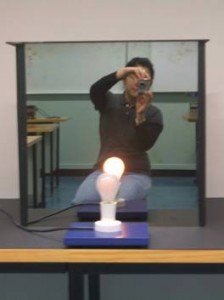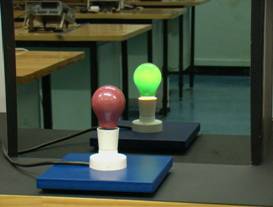Abstract
The half silvered mirror can produce deceptive reflections.
In the photo at right, the red light has a green reflection! See videos below.
Portable
Yes
Principles Illustrated
Reflection in a plane mirror, using parallax to determine the location of an image in a plane mirror, colour mixing, light ray reversibility, properties of so-called “one way” mirrors that are also sometimes called “two-way mirrors.”
NCEA & Science Curriculum
JNR SCI, PHYS 1.4, PHYS 2.3, SCI 2.9, SCI 3.6
Video
Strange Reflections part 1:Â Strange-reflections1
(right-click, save as. m4v file, 66 KB)
Strange reflections part 2: Strangereflections2
(right-click, save as. m4v file, 66 KB)
Instructions

The apparatus consists of a box with a half silvered mirror. The box has been painted flat black, blackboard paint is quite suitable. The box has no top or bottom, but a lid is required to prevent stray light from entering the box. A less expensive alternative to the half silvered mirror glass is a mirror tint film,(available from window film manufacturers, e.g. Profilm, Hamilton for $10/m, 500m wide, however, the film needs to be properly attached to the glass). Two lamp holders are wired and placed, one inside the box, one outside. These should be wired to a dimmer to get the illusion to work properly as relative light levels are critical. With the lamp in the box turned on, adjust the position of the outside lamp until the image of the outside lamp perfectly overlaps the inside lamp. Now the outside lamp is off while the reflection it’s reflection is on (really the inside bulb). Students setting this illusion up can measure the distances to the half silvered mirror for both lamps to show that the image and object are the same distance from the mirrored surface. By turning on the inside lamp and leaving the outside one off the illusion is complete. Alternatives include using red and green lamps, one inside and one outside the box. Colour mixing of light can be demonstrated by illuminating either or both lamps to varying degrees using the dimmer.
Safety
Be sure to use tempered glass, pay attention to electrical safety.
Individual teachers are responsible for safety in their own classes. Even familiar demonstrations should be practised and safety-checked by individual teachers before they are used in a classroom.
Related Resources
- One-way mirror
- Candle under water
- Various colour mixing demos, and colour perception.
Teaching Resources
Would you like to contribute lesson suggestions? Contact us.
Credits
This teaching resource was developed with support from and the help of VUW student Nguyen Nguyen.
This teaching resource was developed in collaboration with Rory O’Keeffe, a New Zealand Science, Mathematics and Technology Teacher Fellow, 2007, hosted by Victoria University School of Chemical and Physical Sciences. Rory is a science teacher by training and was Deputy Principal at Lytton High School in Gisborne, New Zealand. He is also an amateur astronomer. See NZSMT Teacher Fellowships for more information about the Teacher Fellow Program.
This teaching resource was developed with support from
The MacDiarmid Institute
Faculty of Science, Victoria University of Wellington
School of Chemical and Physical Sciences, Victoria University of Wellington
